meta分析 网络meta分析实战教程
- 格式:pdf
- 大小:110.98 KB
- 文档页数:9

meta分析教程Step 1: Formulate your research questionBefore conducting a meta-analysis, it is crucial to clearly define your research question or objective. This will help guide your search for relevant studies and determine the criteria for including or excluding studies from your analysis.The next step is to perform an extensive literature search to identify all relevant studies on your research question. This can be done by searching electronic databases, such as PubMed or Google Scholar, using specific keywords and inclusion/exclusion criteria. Additionally, it may be helpful to review the reference lists of selected articles to find additional studies that were missed during the initial search.Step 3: Screen and select studiesStep 4: Extract data from selected studiesStep 5: Assess study quality and risk of biasTo evaluate the quality and risk of bias of the included studies, a critical appraisal should be conducted. This involves assessing factors such as study design, sample size, blinding, randomization, and potential sources of bias. Various tools and checklists, such as the Cochrane Collaboration's Risk of Bias Tool, can be used to systematically assess the quality of individual studies.Step 6: Analyze the dataStep 7: Assess heterogeneityHeterogeneity refers to the variability in effect sizes across studies. It is important to assess and quantify heterogeneity using statistical tests, such as the Q test or I² statistic. If significant heterogeneity is present, subgroup analyses or sensitivity analyses may be conducted to explore potential sources of heterogeneity.Step 8: Publication bias assessmentPublication bias occurs when studies with statistically significant results are more likely to be published, while studies with nonsignificant or negative findings remain unpublished. To assess publication bias, funnel plots can be used to visually examine the symmetry of the distribution of effect sizes. Statistical tests, such as Egger's regression or Begg's rank correlation, can also be applied to quantify the degree of asymmetry.Step 9: Interpret and report the findingsFinally, the results of the meta-analysis should be interpreted and reported in a clear and concise manner. The findings should be discussed in light of the research question, the characteristics of the included studies, and the limitationsof the analysis. Conclusions should be drawn based on the strength of evidence provided by the meta-analysis.。
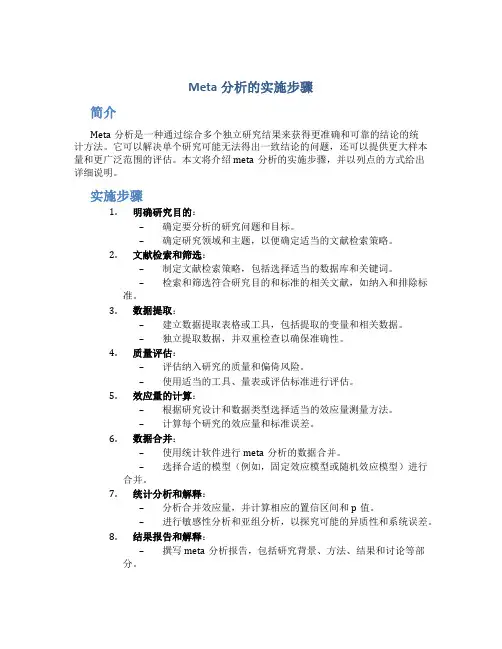
Meta分析的实施步骤简介Meta分析是一种通过综合多个独立研究结果来获得更准确和可靠的结论的统计方法。
它可以解决单个研究可能无法得出一致结论的问题,还可以提供更大样本量和更广泛范围的评估。
本文将介绍meta分析的实施步骤,并以列点的方式给出详细说明。
实施步骤1.明确研究目的:–确定要分析的研究问题和目标。
–确定研究领域和主题,以便确定适当的文献检索策略。
2.文献检索和筛选:–制定文献检索策略,包括选择适当的数据库和关键词。
–检索和筛选符合研究目的和标准的相关文献,如纳入和排除标准。
3.数据提取:–建立数据提取表格或工具,包括提取的变量和相关数据。
–独立提取数据,并双重检查以确保准确性。
4.质量评估:–评估纳入研究的质量和偏倚风险。
–使用适当的工具、量表或评估标准进行评估。
5.效应量的计算:–根据研究设计和数据类型选择适当的效应量测量方法。
–计算每个研究的效应量和标准误差。
6.数据合并:–使用统计软件进行meta分析的数据合并。
–选择合适的模型(例如,固定效应模型或随机效应模型)进行合并。
7.统计分析和解释:–分析合并效应量,并计算相应的置信区间和p值。
–进行敏感性分析和亚组分析,以探究可能的异质性和系统误差。
8.结果报告和解释:–撰写meta分析报告,包括研究背景、方法、结果和讨论等部分。
–解释结果的实际意义和潜在影响,讨论研究结果的局限性和不确定性。
9.提出结论:–总结meta分析的主要结论和发现。
–提出未来研究的建议和方向。
总结通过执行上述meta分析的实施步骤,研究者可以综合多个独立研究的结果,提供更准确和可靠的结论。
这种方法对于整合和综合现有证据,获得更具统计学意义的结论具有重要意义。
然而,执行meta分析时需要详细考虑文献检索、数据提取、质量评估等关键步骤,并以透明和系统的方式进行分析和报告。

r语言跑网络meta分析的流程下载温馨提示:该文档是我店铺精心编制而成,希望大家下载以后,能够帮助大家解决实际的问题。
文档下载后可定制随意修改,请根据实际需要进行相应的调整和使用,谢谢!并且,本店铺为大家提供各种各样类型的实用资料,如教育随笔、日记赏析、句子摘抄、古诗大全、经典美文、话题作文、工作总结、词语解析、文案摘录、其他资料等等,如想了解不同资料格式和写法,敬请关注!Download tips: This document is carefully compiled by theeditor.I hope that after you download them,they can help yousolve practical problems. The document can be customized andmodified after downloading,please adjust and use it according toactual needs, thank you!In addition, our shop provides you with various types ofpractical materials,such as educational essays, diaryappreciation,sentence excerpts,ancient poems,classic articles,topic composition,work summary,word parsing,copy excerpts,other materials and so on,want to know different data formats andwriting methods,please pay attention!R语言进行网络Meta分析的详细流程网络Meta分析是一种统计方法,用于整合多个研究结果,特别是在存在多种干预措施或比较组时。
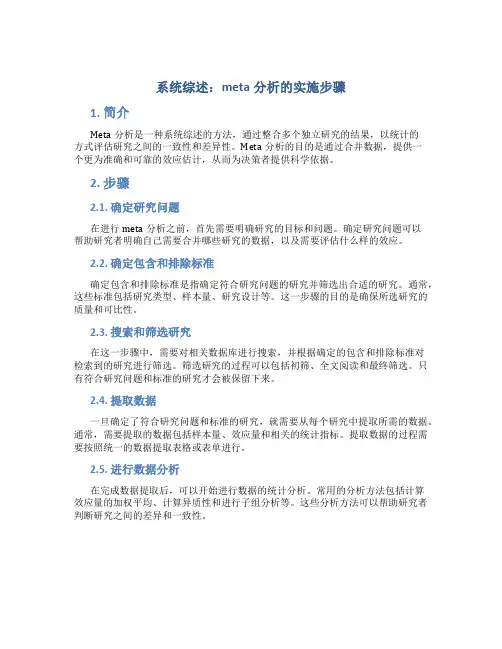
系统综述:meta分析的实施步骤1. 简介Meta分析是一种系统综述的方法,通过整合多个独立研究的结果,以统计的方式评估研究之间的一致性和差异性。
Meta分析的目的是通过合并数据,提供一个更为准确和可靠的效应估计,从而为决策者提供科学依据。
2. 步骤2.1. 确定研究问题在进行meta分析之前,首先需要明确研究的目标和问题。
确定研究问题可以帮助研究者明确自己需要合并哪些研究的数据,以及需要评估什么样的效应。
2.2. 确定包含和排除标准确定包含和排除标准是指确定符合研究问题的研究并筛选出合适的研究。
通常,这些标准包括研究类型、样本量、研究设计等。
这一步骤的目的是确保所选研究的质量和可比性。
2.3. 搜索和筛选研究在这一步骤中,需要对相关数据库进行搜索,并根据确定的包含和排除标准对检索到的研究进行筛选。
筛选研究的过程可以包括初筛、全文阅读和最终筛选。
只有符合研究问题和标准的研究才会被保留下来。
2.4. 提取数据一旦确定了符合研究问题和标准的研究,就需要从每个研究中提取所需的数据。
通常,需要提取的数据包括样本量、效应量和相关的统计指标。
提取数据的过程需要按照统一的数据提取表格或表单进行。
2.5. 进行数据分析在完成数据提取后,可以开始进行数据的统计分析。
常用的分析方法包括计算效应量的加权平均、计算异质性和进行子组分析等。
这些分析方法可以帮助研究者判断研究之间的差异和一致性。
2.6. 评估偏倚风险评估偏倚风险是meta分析中非常重要的一步,它可以帮助研究者判断所选研究的质量和可信度。
常用的评估偏倚风险的工具包括Cochrane Collaboration’s risk of bias tool和Newcastle-Ottawa Quality Assessment Scale等。
2.7. 进行结果的解释和展示完成数据分析后,需要对结果进行解释和展示。
可以通过表格、图形和描述性文字等方式来呈现结果。
此外,还可以进行敏感性分析和亚组分析等进一步分析,以检验结果的稳定性和可靠性。



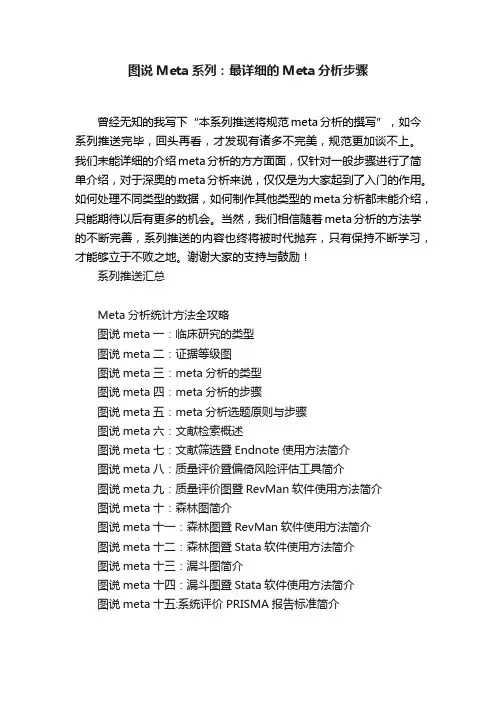
图说Meta系列:最详细的Meta分析步骤
曾经无知的我写下“本系列推送将规范meta分析的撰写”,如今系列推送完毕,回头再看,才发现有诸多不完美,规范更加谈不上。
我们未能详细的介绍meta分析的方方面面,仅针对一般步骤进行了简单介绍,对于深奥的meta分析来说,仅仅是为大家起到了入门的作用。
如何处理不同类型的数据,如何制作其他类型的meta分析都未能介绍,只能期待以后有更多的机会。
当然,我们相信随着meta分析的方法学的不断完善,系列推送的内容也终将被时代抛弃,只有保持不断学习,才能够立于不败之地。
谢谢大家的支持与鼓励!
系列推送汇总
Meta分析统计方法全攻略
图说meta一:临床研究的类型
图说meta二:证据等级图
图说meta三:meta分析的类型
图说meta四:meta分析的步骤
图说meta五:meta分析选题原则与步骤
图说meta六:文献检索概述
图说meta七:文献筛选暨Endnote使用方法简介
图说meta八:质量评价暨偏倚风险评估工具简介
图说meta九:质量评价图暨RevMan软件使用方法简介
图说meta十:森林图简介
图说meta十一:森林图暨RevMan软件使用方法简介
图说meta十二:森林图暨Stata软件使用方法简介
图说meta十三:漏斗图简介
图说meta十四:漏斗图暨Stata软件使用方法简介
图说meta十五:系统评价PRISMA报告标准简介。
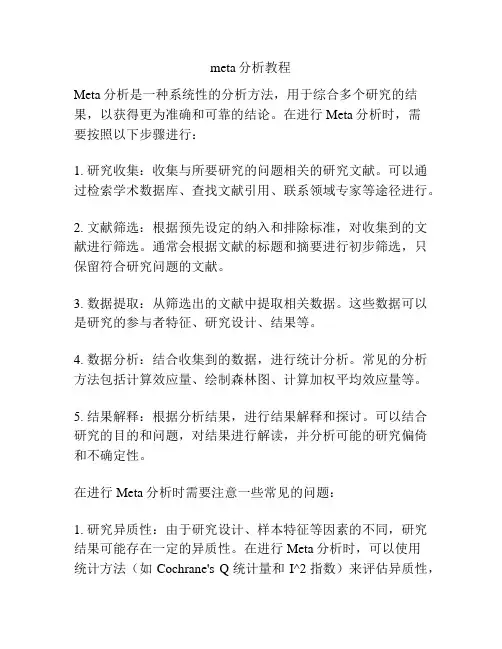
meta分析教程Meta分析是一种系统性的分析方法,用于综合多个研究的结果,以获得更为准确和可靠的结论。
在进行Meta分析时,需要按照以下步骤进行:1. 研究收集:收集与所要研究的问题相关的研究文献。
可以通过检索学术数据库、查找文献引用、联系领域专家等途径进行。
2. 文献筛选:根据预先设定的纳入和排除标准,对收集到的文献进行筛选。
通常会根据文献的标题和摘要进行初步筛选,只保留符合研究问题的文献。
3. 数据提取:从筛选出的文献中提取相关数据。
这些数据可以是研究的参与者特征、研究设计、结果等。
4. 数据分析:结合收集到的数据,进行统计分析。
常见的分析方法包括计算效应量、绘制森林图、计算加权平均效应量等。
5. 结果解释:根据分析结果,进行结果解释和探讨。
可以结合研究的目的和问题,对结果进行解读,并分析可能的研究偏倚和不确定性。
在进行Meta分析时需要注意一些常见的问题:1. 研究异质性:由于研究设计、样本特征等因素的不同,研究结果可能存在一定的异质性。
在进行Meta分析时,可以使用统计方法(如Cochrane's Q统计量和I^2指数)来评估异质性,并考虑采用随机效应模型进行分析。
2. 研究偏倚:由于公开发表结果可能存在选择性报道和发表偏倚,Meta分析也可能受到研究偏倚的影响。
可以通过绘制漏斗图和进行敏感性分析等方法来评估研究偏倚的影响。
3. 数据质量评估:在进行Meta分析时,需要对包含的研究进行质量评估。
可以使用工具(如Cochrane Risk of Bias工具)对研究的内部有效性进行评估,并根据评估结果进行结果解释和结论推断。
综上所述,Meta分析是一种有效的综合研究结果的方法,能够更全面地了解某一研究问题。
在进行Meta分析时,需要对研究进行收集、筛选、数据提取、数据分析和结果解释等步骤,并需要注意研究异质性、研究偏倚和数据质量等问题。
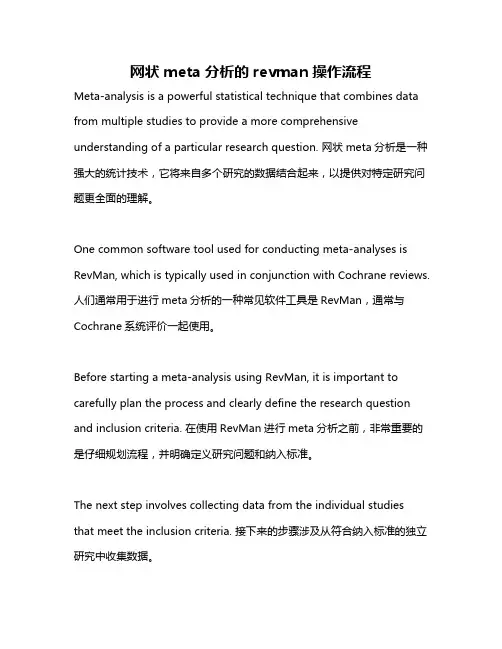
网状meta分析的revman操作流程Meta-analysis is a powerful statistical technique that combines data from multiple studies to provide a more comprehensive understanding of a particular research question. 网状meta分析是一种强大的统计技术,它将来自多个研究的数据结合起来,以提供对特定研究问题更全面的理解。
One common software tool used for conducting meta-analyses is RevMan, which is typically used in conjunction with Cochrane reviews. 人们通常用于进行meta分析的一种常见软件工具是RevMan,通常与Cochrane系统评价一起使用。
Before starting a meta-analysis using RevMan, it is important to carefully plan the process and clearly define the research question and inclusion criteria. 在使用RevMan进行meta分析之前,非常重要的是仔细规划流程,并明确定义研究问题和纳入标准。
The next step involves collecting data from the individual studies that meet the inclusion criteria. 接下来的步骤涉及从符合纳入标准的独立研究中收集数据。
Once the data has been collected, it can be entered into RevMan to conduct the meta-analysis. 一旦数据已经收集完毕,就可以将其输入到RevMan中进行meta分析。

Meta分析的完整步骤Meta分析的完整步骤,根据个人的体会,结合战友的经验总结而成,meta的精髓就是对文献的二次加工和定量合成,所以这个总结也算是对战友经验的meta分析吧.一、选题和立题〔一〕形成需要解决的临床问题:系统评价可以解决下列临床问题:1.病因学和危险因素研究;2.治疗手段的有效性研究;3.诊断方法评价;4.预后估计;5.病人费用和效益分析等.进行系统评价的最初阶段就应对要解决的问题进行精确描述,包括人群类型<疾病确切分型、分期> 、治疗手段或暴露因素的种类、预期结果等,合理选择进行评价的指标.〔二〕指标的选择直接影响文献检索的准确性和敏感性,关系到制定检索策略.〔三〕制定纳入排除标准.二、文献检索〔一〕检索策略的制定这是关键,要求查全和查准.推荐Mesh联合free word检索.〔二〕文献检索,获取摘要和全文国内的有维普全文VIP,CNKI,万方数据库,外文的有medline ,SD,OVID等.〔三〕文献管理强烈推荐使用endnote,procite,noteexpress等文献管理软件进行检索和管理文献.查找文献全文的途径:在这里,讲一下找文献的过程,以请后来的战友们参考〔不包括网上有电子全文的〕:1.查找免费全文:〔1〕在pubmed center中看有无免费全文.有的时候虽然没有显示free full text,但是点击进去看全文也有提供免费全文的.我就碰到几次.〔2〕在google中搜一下.少数情况下,NCBI没有提供全文的,google有可能会找到,使用"学术搜索".本人虽然没能在google中找到一篇所需的文献,但发现了一篇非常重要的综述,里面包含了所有我需要的文献〔当然不是数据〕,但起码提供了一个信息,所需要的文献也就这么多了,因为老外的综述也只包含了这么多的内容.这样,到底找多少文献,找什么文献,心里就更有底了.〔3〕免费医学全文杂志. freemedicaljournals .提供很过超过收费期的免费全文.2.图书馆查馆藏目录:包括到本校的,当然方便,使用pubmed的linkout看文献收录的数据库,就知道本校的是否有全文.其它国内高校象复旦、北大、清华等医学院的全文数据库都很全,基本上都有权限.##的就有华东地区联目、查国内各医学院校的图书馆联目.这里给出几个:〔1〕中国高等院校医药图书馆协会的地址:://server14.library.imicams.ac/xiehui/chengyuan.htm,进入左侧的"现刊联目",可以看到有"现刊联目查询"和"过刊联目查询",当然,查询结果不可全信,里面有许多错误.本人最难找的两篇文章全部给出了错误的信息〔后来联系证实的〕.<2>再给出两个比较好的图书馆索要文献的email地址〔有偿服务〕,但可以先提供文献,后汇钱,当然做为我们,一定要讲信誉吆.一是解放军医学图书馆信息部:##bmlplasina , :010********;〔3〕二是复旦大学医科图书馆〔原上医〕:,联系人,周月琴,王蔚之,郑荣, ,021-********,需下载文献传递申请表〔://202.120.76.225/ill.doc〕.其他的图书馆要么要求先交开户费,比如协和〔500元〕,要么嫌麻烦,虽然网上讲过可提供有偿服务,在这里我就不一一列出了.3.请DXY战友帮忙,在馆藏文献互助站中发帖,注意格式正确,最好提供linkout的多个数据库的全文,此时为帮助的人着想,就是帮助自己.自己也同时帮助别人查文献,一来互相帮助,我为人人,人人为我.二则通过帮助别人可以积分,同时学会如何发帖和下载全文,我就感觉通过帮助别人收获很大,自己积分越高,获助的速度和机会也就相应增加.现在不少免费的网络空间〔我常用爱存isload 〕,比发简便很多.所以如果你求助以后,要与时去"我的论坛"中查看帖子,有的很快就把下载发过来了,不要一味只看.4.实在不行,给作者发email.这里给出一个查作者email的方法,先在NCBI中查出原文献作者的所有文章,注意不要只限于第一作者,display,abstract, 并尽可能显示多的篇数,100,200,500.然后在网页内查找"@",一般在@前的字母会与人名有些地方相似.再根据地址来确定是否是同一作者.5.查找杂志的网址,给主编发信求取全文.这里我就不讲查找的方法了,DXY中有许多帖子.我的一篇全文就是这样得到的.6.向国外大学里的朋友求助.国外大学的图书馆一般会通过馆际互借来查找非馆藏文献,且获得率非常高.我的三篇文献是通过这一途径得到的.如果还是找不到,那就……我也没辙了,还有朋友如有其他的方法,不妨来这里交流.难度不小吧,比起做实验来如何?三、对文献的质量评价和数据收集〔一〕研究的质量评价对某一试验研究的质量评价主要是评价试验结果是否有效,结果是什么该结果是否适用于当地人群.下面一系列问题可以帮助研究者进行系统的质量评价:①该研究的试验设计是否明确,包括研究人群、治疗手段和结果判定方法;②试验对象是否随机分组;③病人的随访率是否理想与每组病人是否经过统计分析;④受试对象、研究人员与其它研究参与者是否在研究过程中实行"盲法";⑤各组病人的年龄、性别、职业等是否相似;⑥除进行研究的治疗手段不同外,其它的治疗是否一致;⑦治疗作用大小;⑧治疗效果的评价是否准确;⑨试验结果是否适用于当地的人群,种族差异是否影响试验结果;⑩是否描述了所有重要的治疗结果;治疗取得的效益是否超过了治疗的危险性和费用.系统评价者应根据上述标准进行判断,不满足标准的文献应剔除或区别对待<数据合并方法不同> ,以保证系统评价的有效性.<二>、数据收集研究者应设计一个适合本研究的数据收集表格.许多电子表格制作软件如Excel 、Access ,和数据库系统软件如FoxPro 等,可以用于表格的制作.表格中应包括分组情况、每组样本数和研究效应的测量指标.根据研究目的不同,测量指标可以是率差、比数<odds> 、相对危险度< relative risk ,包括RR 和OR> .各研究间作用测量指标不一致,需转化为统一指标.常用的统一指标是作用大小< Effect Size , ES> ,ES 是两比较组间作用差值除以对照组或合并组的标准差.ES 无单位是其优点.<三>、数据分析系统评价过程中,对上述数据进行定量统计合并的流行病学方法称为Meta分析<Meta analysis> .Meta 意思是more comprehensive ,即更加全面综合.通过Meta分析可以达到以下目的:1.提高统计检验效能;2.评价结果一致性,解决单个研究间的矛盾;3.改进对作用效应的估计;4.解决以往单个研究未明确的新问题.统计分析的指标〔一〕、异质性检验1.检验原理:meta 分析的原理首先是假定各个不同研究都是来自非同一个总体<H0:各个不同样本来自不同总体,存在异质性,备择假设H1,如果p>0.1,拒绝H0,接受H1,,即来自同一总体>这样就要求不同研究间的统计量应该接近总体参数真实值,所以各个不同文献研究结果是比较接近,就是要符合同质性,这时候将所有文献的效应值合并可以采用固定效应模型的有些算法,如倒方差法,mantel haenszel 法,peto法等.2.分类:异质性检验,包括三个方面:临床异质性,统计学异质性和方法学异质性,作meta分析首先应当保证临床同质性,比如研究的设计类型、实验目的、干预措施等相同,否则就要进入亚组分析,或者取消合并,在满足临床同质性的前提下〔非常重要,不能一味追求统计学同质性,首先考虑专业和临床同质性〕,我们进一步观测统计学同质性.临床异质性较大时不能行meta分析,随机效应模型也不行.只能行描述性系统综述〔systemic reviews,SR〕或分成亚组消除临床异质性.解决临床异质后再考虑统计学异质性的问题.如果各个文献研究间结果不存在异质性〔p>0.1〕,选用固定效应模型〔fixed model〕,这时其实选用随即效应模型的结果与固定效应模型相同;如果不符合同质性要求,即异质性检验有显著性意义<p<0.1>,这时候固定效应模型的算法来合并效应值就是有偏倚,合并效应值会偏离真实值.所以,异质性存在时候要求采用随机模型,主要是矫正合并效应值的算法,使得结果更加接近无偏估计,即结果更为准确.此外,这里要说明的是,采用的模型不同,和合并效应值的方法不同,都会导致异质性检验P值存在变动,这个可以从算法原理上证明,不过P值变动不会很大,一般在小数点后第三位的改变.异质性检验的Q 值在固定模型中采用倒方差法和Mantel-haenszel法中也会不同.随机效应模型是不需要假定各个研究来自同一个总体为前提,本来就是对总体参数的近似无偏估计,这个与固定模型不一样〔必须要同质为基础〕,所以随机模型来作异质性检验简直是"画蛇添足",无奈之举!因此,随机模型异质性检验是否有统计学意义都是可以用,而固定模型必须要求无异质性.可以证明和实践,如果无异质性存在的时候,随机模型退化为固定,即固定模型的结果于随机模型的合并效应值是相等的具体见下图:目前,国内外对meta分析存在异质性,尤其是异质性检验P值很小的时候〔具体范围我不清楚,是0.05~0.1吗?请版主补充〕,学术界有着不同的争论,很多人认为这个时候做meta分析是没有意义,相当于合并了一些来自不同总体的统计结果,也有人认为,这些异质性的存在可能是由于文献发表的时间,研究的分组,研究对象的特征等因素引起,只要采用亚组分析或meta回归分析可以将异质性进行控制或解释,还是可以进行meta分析,至少运用随机效应模型可以相对无偏的估计总体.这里要强调的是,异质性检验P值较小时候,最好能对异质性来源进行分析和说明.合理进行解释,同时进行亚组分析,相当于分层分析,消除混杂因素造成的偏倚〔bias〕.3. 衡量异质性的指标一个有用的定量衡量异质性的指标是I2,I2 = [<Q –df>/Q] x 100%,此处的Q是卡方检验的统计值,df 是其自由度〔Higgins 2003, Higgins 2002>.这个I2值代表了由于异质性而不是抽样误差〔机会〕导致的效应占总效应估计值的百分率. I2值大于50%时,可以认为有明显的异质性. 〔二〕、敏感性分析:1.敏感性分析的含义:改变纳入标准〔特别是尚有争议的研究〕、排除低质量的研究、采用不同统计方法/模型分析同一资料等,观察合并指标〔如OR,RR〕的变化,如果排除某篇文献对合并RR有明显影响,即认为该文献对合并RR敏感,反之则不敏感,如果文献之间来自同一总体,即不存在异质性,那么文献的敏感性就低,因而敏感性是衡量文献质量〔纳入和排除文献的证据〕和异质性的重要指标.敏感性分析主要针对研究特征或类型如方法学质量,通过排除某些低质量的研究、或非盲法研究探讨对总效应的影响.〔王吉耀第二版P76中〕"排除某些低质量的研究,再评价,然后前后对比,探讨剔除的试验与该类研究特征或类型对总效应的影响".〔王家良第一版八年制P66、154〕敏感性分析是从文献的质量上来归类,亚组分析主要从文献里分组病例特征分类.敏感性分析是排除低质量研究后的meta分析,或者纳入排除研究后的meta分析.亚组分析是根据纳入研究的病人特点适当的进行分层,过多的分层和过少的分层都是不好的. 例如在排除某个低质量研究后,重新估计合并效应量,并与未排除前的Meta分析结果进行比较,探讨该研究对合并效应量影响程度与结果稳健性.若排除后结果未发生大的变化,说明敏感性低,结果较为稳健可信;相反,若排除后得到差别较大甚至截然相反结论,说明敏感性较高,结果的稳健性较低,在解释结果和下结论的时候应非常慎重,提示存在与干预措施效果相关的、重要的、潜在的偏倚因素,需进一步明确争议的来源.2.衡量方法和措施其实常用的就是选择不同的统计模型或进行亚组分析,并探讨可能的偏倚来源,慎重下结论. 亚组分析通常是指针对研究对象的某一特征如性别、年龄或疾病的亚型等进行的分析,以探讨这些因素对总效应的影响与影响程度.而敏感性分析主要针对研究特征或类型如方法学质量,通过排除某些低质量的研究、或非盲法的研究以探讨对总效应的影响.建议可以看参考王吉耀主编,科学出版的《循证医学与临床实践》.敏感性分析只有纳入可能低质量文献时才作,请先保证纳入文献的质量!纳入文献的质量评价方法,如果是RCT,可选用JADAD评分.如果病因学研究,我认为使用敏感性分析是评价文献质量〔前提是符合纳入标准〕的较为可行的方法.敏感性分析是分析异质性的一种间接方法.有些系统评价在进行异质性检验时发现没有异质性,这时还需不需要作敏感性分析?我的看法是需要,因为我觉得异质性也是可以互相抵消的,有时候作出来没有异质性,但经过敏感性分析之后,结果就会有变化.〔三〕对入选文献进行偏倚估计发表偏倚〔publication bias>评估〔包括作漏斗图,和对漏斗图的对称性作检验〕.可以用stata 软件进行egger检验.人是活的,软件是死的,临床是相对的,统计学是绝对的.四、总结:〔一〕结果的解释Meta-分析结果除要考虑是否有统计学意义外,还应结合专业知识判断结果有无临床意义.若结果仅有统计学意义,但合并效应量小于最小的有临床意义的差值时,结果不可取;若合并效应量有临床意义,但无统计学意义时,不能定论,需进一步收集资料.不能推荐没有Meta-分析证据支持的建议.在无肯定性结论时,应注意区别两种情况,是证据不充分而不能定论,还是有证据表明确实无效.〔二〕结果的推论Meta-分析的结果的外部真实性如何?在推广应用时,应结合该Meta-分析的文献纳入/排除标准,考虑其样本的代表性如何,特别应注意研究对象特征与生物学或文化变异、研究场所、干预措施与研究对象的依从性、有无辅助治疗等方面是否与自己的具体条件一致. 理想的Meta-分析应纳入当前所有相关的、高质量的同质研究,无发表性偏倚,并采用合适的模型和正确统计方法.〔三〕系统评价的完善与应用系统评价完成后,还需要在实际工作中不断完善,包括: ①接受临床实践的检验和临床医师的评价; ②接受成本效益评价; ③关注新出现的临床研究,要与时对系统评价进行重新评价.临床医师只有掌握了系统评价的方法,才能为本专业的各种临床问题提供证据,循证医学才能够顺利发展.。
META节点法是一种常用的网络拓扑结构分析方法,主要用于分析计算机网络中节点之间的连接关系和通信路径。
META节点法的基本思想是将网络中的节点按照一定的规则进行分类和组合,形成不同的节点集合,然后通过对节点集合之间的关系进行分析,得出网络中的拓扑结构和通信路径。
META节点法的主要步骤如下:
1. 确定节点集合:将网络中的节点按照一定的规则进行分类和组合,形成不同的节点集合。
2. 确定集合之间的关系:确定各个节点集合之间的关系,包括集合之间的连接关系和集合内部节点之间的连接关系。
3. 分析节点集合之间的通信路径:通过对节点集合之间的关系进行分析,得出网络中的拓扑结构和通信路径。
需要注意的是,META节点法的具体实现方式可能会因不同的应用场景和需求而有所不同。
在实际应用中,需要根据具体情况进行调整和优化。
Lecture15:mixed-effects logistic regression28November2007In this lecture we’ll learn about mixed-effects modeling for logistic regres-sion.1Technical recapWe moved from generalized linear models(GLMs)to multi-level GLMs by adding a stochastic component to the linear predictor:η=α+β1X1+···+βn X n+b0+b1Z1+···+b m Z m(1) and usually we assume the random effects vector b is normally distributed with mean0and variance-covariance matrixΣ.In a mixed-effects logistic regression model,we simply embed the stochas-tic linear predictor in the binomial error function(recall that in this case, the predicted meanµcorresponds to the binomial parameter p):P(y;µ)=nynµyn(1−µ)(1−y)n(Binomial error distribution)(2)logµ1−µ=η(Logit link)(3)µ=eη1+eη(Inverse logit function)(4)11.1Fitting multi-level logit modelsAs with linear mixed models,the likelihood function for a multi-level logit model must marginalize over the random effects b:∞P( x|β,b)P(b|Σ)d b(5)Lik(β,Σ| x)=−∞Unfortunately,this likelihood cannot be evaluated exactly and thus the maximum-likelihood solution must be approximated.You can read about some of the approximation methods in Bates(2007,Section9).Laplacian approximation to ML estimation is available in the lme4package and is recommended.Penalized quasi-likelihood is also available but not recom-mended,and adaptive Gaussian quadrature is recommended but not yet available.1.2An exampleWe return to the dative dataset and(roughly)follow the example in Baayen Section7.4.We will construct a model with all the available predictors (except for speaker),and with verb as a random effect.First,however,we need to determine the appropriate scale at which to enter the length(in number of words)of the recipient and theme arguments.Intuitively,both raw scales and log scales are plausible.If our response were continuous,a natural thing to do would be to look at scatterplots of each of these variables against the response.With a binary response,however,such a scatterplot is not very informative.Instead,we take two approaches:1.Look at the empirical relationship between argument length and meanresponse,using a shingle;pare single-variable logistic regressions of response against raw/logargument length and see which version has a better log-likelihood.First we will define convenience functions to use for thefirst approach: >tapply.shingle<-function(x,s,fn,...){result<-c()for(l in levels(s)){Linguistics251lecture15notes,page2Roger Levy,Fall2007x1<-x[s>l[1]&s<l[2]]result<-c(result,fn(x1,...))}result}>logit<-function(x){log(x/(1-x))}We then plot the mean response based on shingles(Figure1):>my.intervals<-cbind(1:29-0.5,1:29+1.5)>response<-ifelse(dative$RealizationOfRecipient=="PP",1,0) >recipient.x<-with(dative,tapply.shingle(LengthOfRecipient, shingle(LengthOfRecipient,my.intervals),mean))>recipient.y<-with(dative,tapply.shingle(response, shingle(LengthOfRecipient,my.intervals),mean))>plot(recipient.x,logit(recipient.y))>theme.y<-with(dative,tapply.shingle(response,shingle(LengthOfTheme,my.intervals),mean))>theme.x<-with(dative,tapply.shingle(LengthOfTheme, shingle(LengthOfTheme,my.intervals),mean))>plot(theme.x,logit(theme.y))These plots are somewhat ambiguous and could support either a linear or logarithmic relationship in logit space.(Keep in mind that(a)we’re not seeing points where there are100%of responses that are“successful”or “failures”;and(b)there are very few data points at the larger lengths.) So we resort to the logistic regression approach(recall that the deviance is simply-2times the log-likelihood):>summary(glm(response~LengthOfTheme,dative,family="binomial"))$deviance[1]3583.41>summary(glm(response~log(LengthOfTheme),dative,family="binomial"))$deviance[1]3537.279>summary(glm(response~LengthOfRecipient,dative,Linguistics251lecture15notes,page3Roger Levy,Fall2007Figure1:Responses of recipient and theme based on shinglesfamily="binomial"))$deviance[1]3104.92>summary(glm(response~log(LengthOfRecipient),dative,family="binomial"))$deviance[1]2979.884In both cases the log-length regression has a lower deviance and hence a higher log-likelihood.So we’ll enter these terms into the overall mixed-effects regression as log-lengths.>dative.glmm<-lmer(RealizationOfRecipient~log(LengthOfRecipient)+log(LengthOfTheme)+AnimacyOfRec+AnimacyOfTheme+AccessOfRec+AccessOfTheme+PronomOfRec+PronomOfTheme+DefinOfRec+DefinOfTheme+SemanticClass+Modality+(1|Verb),dative,family="binomial",method="Laplace") >dative.glmm[...]Random effects:Linguistics251lecture15notes,page4Roger Levy,Fall2007Groups Name Variance Std.Dev.Verb(Intercept)4.6872 2.165number of obs:3263,groups:Verb,75Estimated scale(compare to1)0.7931773Fixed effects:Estimate Std.Error z value Pr(>|z|) (Intercept) 1.94630.6899 2.8210.004787** AccessOfThemegiven 1.62660.2764 5.8863.97e-09*** AccessOfThemenew-0.39570.1950-2.0290.042451* AccessOfRecgiven-1.24020.2264-5.4794.28e-08*** AccessOfRecnew0.27530.2472 1.1130.265528log(LengthOfRecipient) 1.28910.15528.306<2e-16*** log(LengthOfTheme)-1.14250.1100-10.390<2e-16*** AnimacyOfRecinanimate 2.18890.26958.1234.53e-16*** AnimacyOfThemeinanimate-0.88750.4991-1.7780.075334. PronomOfRecpronominal-1.55760.2491-6.2534.02e-10*** PronomOfThemepronominal 2.14500.26548.0816.40e-16*** DefinOfRecindefinite0.78900.2087 3.7800.000157*** DefinOfThemeindefinite-1.07030.1990-5.3797.49e-08*** SemanticClassc0.40010.3744 1.0690.285294 SemanticClassf0.14350.61520.2330.815584 SemanticClassp-4.1015 1.5371-2.6680.007624** SemanticClasst0.25260.2137 1.1820.237151 Modalitywritten0.13070.20960.6230.533008 (Incidentally,this model has higher log-likelihood than the same model with raw instead of log-argument length,supporting our choice of log-length as the preferred predictor.)Thefixed-effect coefficients can be interpreted as normal in a logistic regression.It is important to note that there is considerable variance in the random effect of verb.The scale of the random effect is that of the linear predictor,and if we consult the logistic curve we can see that a standard deviation of2.165means that it would be quite typical for the magnitude of this random effect to be the difference between a PO response probability of 0.1and0.5.Linguistics251lecture15notes,page5Roger Levy,Fall2007Figure2:Random intercept for each verb in analysis of the dative dataset Because of this considerable variance of the effect of verb,it is worthlooking at the BLUPs for the random verb intercept:>nms<-rownames(ranef(dative.glmm)$Verb)>intercepts<-ranef(dative.glmm)$Verb[,1]>support<-tapply(dative$Verb,dative$Verb,length)>labels<-paste(nms,support)>barplot(intercepts[order(intercepts)],names.arg=labels[order(intercepts)], las=3,mgp=c(3,-0.5,0),ylim=c(-6,4))#mgp fix to give room for verb names The results are shown in Figure2.On the labels axis,each verb is followedby its support:the number of instances in which it appears in the dativedataset.Verbs with larger support will have more reliable random-interceptBLUPs.From the barplot we can see that verbs including tell,teach,andshow are strongly biased toward the double-object construction,whereassend,bring,sell,and take are strongly biased toward the prepositional-object construction.This result is theoretically interesting because the dative alternation hasbeen at the crux of a multifaceted debate that includes:•whether the alternation is meaning-invariant;•if it is not meaning-invariant,whether the alternants are best handledvia constructional or lexicalist models;•whether verb-specific preferences observable in terms of raw frequencytruly have their locus at the verb,or can be explained away by otherproperties of the individual clauses at issue.Linguistics251lecture15notes,page6Roger Levy,Fall2007Because verb-specific preferences in this model play such a strong role de-spite the fact that many other factors are controlled for,we are on betterfooting to reject the alternative raised by the third bullet above that verb-specific preferences can be entirely explained away by other properties of theindividual clauses.Of course,it is always possible that there are other ex-planatory factors correlated with verb identity that will completely explainaway verb-specific preferences;but this is the nature of science.(This is alsoa situation where controlled,designed experiments can play an importantrole by eliminating the correlations between predictors.)1.3Model comparison&hypothesis testingFor nested mixed-effects logit models differing only infixed-effects structure,likelihood-ratio tests can be used for model comparison.Likelihood-ratiotests are especially useful for assessing the significance of predictors consistingof factors with more than two levels,because such a predictor simultaneously introduces more than one parameter in the model:>dative.glmm.noacc<-lmer(RealizationOfRecipient~log(LengthOfRecipient)+log(LengthOfTheme)+AnimacyOfRec+AnimacyOfTheme+PronomOfRec+PronomOfTheme+DefinOfRec+DefinOfTheme+SemanticClass+Modality+(1|Verb),dative,family="binomial",method="Laplace")>anova(dative.glmm,dative.glmm.noaccessibility)[...]Df AIC BIC logLik Chisq Chi Df Pr(>Chisq) dative.glmm.noacc151543.961635.31-756.98dative.glmm191470.931586.65-716.4681.0274<2.2e-16*** >dative.glmm.nosem<-lmer(RealizationOfRecipient~log(LengthOfRecipient)+log(LengthOfTheme)+AnimacyOfRec+AnimacyOfTheme+AccessOfRec+AccessOfTheme+PronomOfRec+PronomOfTheme+DefinOfRec+DefinOfTheme+Modality+(1|Verb),dative,family="binomial",method="Laplace")>anova(dative.glmm,dative.glmm.nosem)Linguistics251lecture15notes,page7Roger Levy,Fall2007Figure3:Thefit between predicted and observed probabilities for each decileof predicted probability for dative.glmm[...]Df AIC BIC logLik Chisq Chi Df Pr(>Chisq) dative.glmm.nosem151474.551565.90-722.27dative.glmm191470.931586.65-716.4611.61840.02043*1.4Assessing a logit modelWhen assessing thefit of a model whose response is continuous,a plot of the residuals is always useful.This is not a sensible strategy for assessing thefit of a model whose response is categorical.Something that is often doneinstead is to plot predicted probability against observed proportion for somebinning of the data.This process is described in Baayen page305,throughthe languageR function plot.logistic.fit.fnc():>plot.logistic.fit.fnc(dative.glmm,dative)This is really a very goodfit.Finally,a slight word of warning:our model assumed that the randomverb-specific intercepts are normally distributed.As a sanity check,we canuse the Shapiro-Wilk test to check the distribution of BLUPs for the intercepts:Linguistics251lecture15notes,page8Roger Levy,Fall2007>shapiro.test(ranef(dative.glmm)$Verb[,1])Shapiro-Wilk normality testdata:interceptsW=0.9584,p-value=0.0148There is some evidence here that the intercepts are not normally distributed. This is more alarming given that the model has assumed that the intercepts are normally distributed,so that it is biased toward assigning BLUPs that adhere to a normal distribution.2Further ReadingThere is good theoretical coverage(and some examples)of GLMMs in Agresti (2002,Chapter12).There is a bit of R-specific coverage in Venables and Ripley(2002,Section10.4)which is useful to read as a set of applie examples, but the code they present uses penalized quasi-likelihood estimation and this is outdated by lme4.ReferencesAgresti,A.(2002).Categorical Data Analysis.Wiley,second edition. Bates,D.(2007).Linear mixed model implementation in lme4.Manuscript, University of Wisconsin,15May2007.Venables,W.N.and Ripley,B.D.(2002).Modern Applied Statistics with S. Springer,fourth edition.Linguistics251lecture15notes,page9Roger Levy,Fall2007。